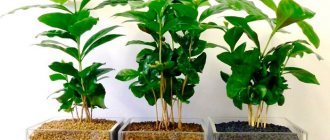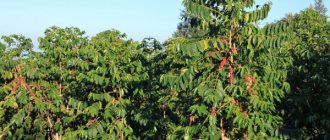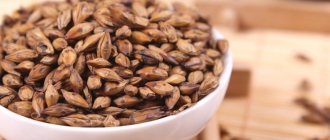Many amateur flower growers dream of having a coffee tree in their collection. Some of them believe that only specialists can cultivate it. However, this is a misconception. Arabica coffee is a houseplant that can be grown at home on a windowsill if you provide the plant with proper care.
Arabica coffee is a perennial shrub or small tree from the Rubiaceae genus. Its homeland is Africa or Asia; it is currently grown in many countries around the world.
The flower is distinguished by thick, bright green, shiny foliage. The leaf blades are sharp at the ends, with well-defined veins. The branches-trunks are slender, thin and at the same time very flexible. They can reach 15 cm in height.
But most of all, the coffee plant is loved for its flowers, which look like small stars, very reminiscent of jasmine flowers. These white petals with an incredibly pleasant aroma can be seen in the spring when the buds bloom.
They bloom for only a couple of days. And after 6 months, red or black fruits appear in this place. In their shape they resemble cherries, but oblong. Each “cherry” produces two coffee beans. They are what delight coffee lovers in the morning.
Temperature
Although the coffee tree grows in the tropics, it does not tolerate heat and scorching sun rays. If the plant is too hot, it will not bloom. The tree should be placed in a well-lit place, but so that direct sunlight does not fall on it. If the window in the room faces south, then the flowerpot should be located at a distance of approximately 1.5 m from the glass.
Optimal room temperature for wood:
- in the warm season – from +23 to +25 °C;
- in winter – +17 °C, in extreme cases – not lower than +15 °C.
When caring for a coffee tree, you need to take into account that it does not tolerate changes in orientation in space. Experts do not recommend turning the flowerpot more often than once every 5 years, otherwise the plant will drop its flowers. To make the crown symmetrical, you can place a mirror next to the coffee tree (but so that direct sunlight is not reflected).
Plant diseases
Coffee tree diseases at home most often develop due to improper care.
When growing an exotic plant, gardeners may encounter the following problems:
- the appearance of brown or purple spots on the foliage is a common sign of phosphorus deficiency in the soil;
- dryness and darkening of the edges of the leaf plates - indicates insufficient air humidity;
- brown tint of leaves - appears when there is a lack of nitrogen in the soil;
- yellowing of foliage - may indicate rot of the tree’s root system;
- holes of various sizes on leaf plates are a common result of sunburn;
- falling leaves in winter - insufficient lighting of the plant;
- slow growth, short flowering period - indicate a lack of nutrients and the need to use fertilizers.
The coffee tree is a tropical plant that, subject to the rules and nuances, can be grown on a windowsill. It will not only become a bright and original interior decoration, but will also fill the room with a rich, pleasant aroma.
Watering
The coffee tree loves moisture, but if the water stagnates in the flowerpot, the roots will begin to rot. Therefore, the plant cannot be flooded, and drainage must be placed at the bottom of the pot. If the tree does not have enough water, the leaves droop and become limp, but after watering they rise very quickly.
The frequency of watering depends on the temperature and humidity. To ensure that the plant does not lack moisture, it is watered with settled water when the substrate in the pot dries at a depth of 1 cm from the surface.
Approximate watering schedule:
- in the warm season - once every 2-3 days;
- in winter - once a week, the water temperature should be 2-3 degrees higher than the air temperature in the room.
From May to September, the coffee tree is sprayed with water from a spray bottle every 1-2 days. To wash off dust from the leaves, wipe them with a damp cloth. The plant can be washed in the shower once a month.
Rejuvenation
Unfortunately, about 10 years after planting, coffee begins to age. The decorative value of the plant decreases. The leaves become yellowish and limp. So, it's time to rejuvenate.
To do this, cut the stems. The procedure must be carried out with a sharp instrument so that the cuts are neat and even. Do not break the shoots under any circumstances! Even if the tree survives, it will finally lose its decorative effect and become ugly.
Don't forget to treat the cut areas with crushed activated carbon.
ON A NOTE. By the way, cuttings are taken from the cut branches for propagation.
The soil
The coffee tree likes acidic soil (pH in the range of 5–5.5). Acidity can be measured using litmus paper.
To obtain such a substrate, mix:
- 1 part peat;
- 2 parts river sand;
- 2 parts leaf soil;
- 4 parts manure humus;
- 4 parts of turf land;
- some finely chopped sphagnum moss.
Of the store-bought soil mixtures, the substrate for citrus fruits is ideal for a coffee tree.
Scientific name
The coffee tree may be called simply Coffee for short. This plant species belongs to the Madder family. There are more than 70 different types of coffee. The most famous types:
- Arabian, also called Arabica;
- Bengal;
- Robusta, or Congolese;
- Cameroonian;
- Liberian.
The following tree-like indoor plants are also grown at home: Ficus “Eden”, “Black Prince”, “Bengal”, “Kinki”, Cypress “Goldcrest Wilma”, Avocado, Lemons “Panderosa”, “Pavlovsky”, some types of ornamental conifers and others . Many of them are suitable for creating bonsai.
Top dressing
The coffee tree blooms and bears fruit intensively, so it needs increased nutrition. It is best to buy a complex fertilizer. The universal organic fertilizer “Miracle of Fertility Sapropel” is well suited for feeding the coffee tree, as well as fertilizers for indoor flowers based on chicken droppings. During the flowering period, the tree can be watered 1-2 times with water infused with straw ash: it is rich in potassium.
Feeding schedule:
- from March to October – once every 2 weeks;
- from November to February – once a month.
If the leaves become dull, wipe them with water and lemon juice (2-3 teaspoons of juice per 1 liter of water). Water the plant with the remainder of the solution (but not more than once a month).
Flowering conditions
The coffee tree blooms in spring. It forms umbrella-shaped inflorescences consisting of small white flowers. At the same time, the tree emits a pleasant aroma.
REFERENCE. The coffee tree fades very quickly. Don't miss this amazing moment!
You can also help the plant bloom. To do this, gently shake the branches on which the inflorescences appeared. Another way is to take a cotton swab or soft brush and touch the flowers. This will cause artificial pollination.
After flowering, fruits begin to set. They ripen almost throughout the spring-summer period, and in some cases the process can even take 1.5 – 2 years.
IMPORTANT! In order for coffee to bloom bright and memorable, it needs to be allowed to rest in winter. During the dormant period, you will have to reduce watering and eliminate the application of fertilizers. You also need to slightly reduce the temperature.
Transfer
If the root system has filled the flowerpot, it means it’s time to replant the tree. Plants up to 3 years old are replanted every year. Then the transplant is carried out once every 2–3 years. The pot should be 5–6 cm larger in diameter than the previous one. If an adult plant bears fruit, then it should be replanted immediately after harvesting, before flowering begins (occurs in about a month).
Drainage is placed at the bottom of the flowerpot: expanded clay, clay shards, nut shells or apricot kernels. 1–2 cm of river sand is poured on top, and then a soil mixture prepared in advance.
The coffee tree is replanted together with an earthen lump (transshipment). The root collar should be slightly raised above the soil level in the flowerpot. If the soil subsequently settles due to watering, exposing the upper part of the roots, a layer of rotted manure humus or weathered peat should be poured into the pot.
Features of seeds
A ripe berry consists of pulp and two grains, suitable for planting in the soil. The coffee plant is very demanding of the environment. Common varieties used for planting:
- Maragogyp;
- Abbisinka;
- Bourbon;
- Mundo novo.
Maragodzhip has a distinctive feature. Among all varieties of coffee, its grains are “giant” in size. Suitable for planting in any soil. The peculiarity of the variety is that it acquires a different aroma and taste when grown in different (composition) soil.
For all varieties, there is a certain natural condition - only plants grown at an altitude of 1-2 kilometers above sea level bear fruit.
Pruning and crown formation
Seedlings of coffee trees are suitable for growing in standard form. Seedlings obtained from cuttings, over time, if you do not form a standard, turn into a dense bush of a spherical shape.
Arabica coffee tree blooming
In the first year, the shoot grows straight upward; there is no need to pinch it. The tree begins to branch in the second year. If you want to form a trunk with a thick crown, you can make a constriction:
- the operation is carried out in late February - early March;
- when the central trunk grows to 25–30 cm, it is tied tightly with reinforced wire at a height of 15–20 cm, 1 cm below the internode;
- pinch the upper bud; if necessary, trim the shoot so that 2 internodes remain above the wire;
- subsequently, all branches above the constriction that grow upward are cut off. The remaining branches are trimmed to your liking to make the tree look aesthetically pleasing;
- after 3–4 years the constriction is loosened, and after a month it is removed. As a result, with a tree height of 50 cm, the crown diameter can reach 1.5 m.
Popular varieties
Coffee is not the most numerous genus of plants. There are only a few dozen species. The following plant varieties are most often grown indoors.
Arabica (Arabian coffee)
It is a low tree with oval leaves. The leaf blades have an olive tint. The flowers are very small. The fruits are burgundy.
Arabica is the most popular variety of coffee to grow indoors.
Nana (Dwarf coffee)
A very beautiful small tree (up to 80 cm) with glossy leaves. Unlike other varieties of coffee, it bears fruit very well in an apartment. Has high decorative value. Loves being sprayed.
Liberian coffee
A tree with a thin trunk and large (30-40 cm) leaves. Unlike other varieties, Liberian coffee has leaf plates that are more rounded towards the end. Fruits abundantly. The berries are yellowish-red. It lends itself well to pruning and crown shaping.
How to start a coffee tree at home
The best option for your home is an Arabica coffee tree. Robusta, although less fastidious, requires cross-pollination, so it is more difficult to get it to bear fruit. If you don’t have enough space in your house, you can buy dwarf Arabica beans or sprouts, one of the most popular varieties is Albert.
There are 3 ways to get a coffee tree:
- sprout from a grain;
- grow a cutting;
- buy in the store.
Growing coffee trees from beans
Ordinary green coffee beans intended for making a drink are unsuitable for germination: they have been collected too long ago and, in addition, they are subjected to special processing.
Coffee beans harvested no more than 1–1.5 months ago have the best germination. Such seeds can be purchased in online stores.
But it is best to ask the owner of the coffee tree for a ripe berry. Nature itself has covered the coffee beans with juicy pulp, so there is no need to soak them.
The optimal temperature for seed germination is from +19 to +24 °C.
Soil composition for sowing:
- 1 part peat;
- 1 part sand;
- 2 parts of turf land.
- The soil mixture must be prepared 2 weeks before sowing.
- Sowing berries:
- the soil in the pot should be moist;
- The berry is placed on its side (flat side down) in a hole approximately 1 cm deep, sprinkled with earth, which is lightly pressed;
- The pot is covered with a jar and placed in a warm, bright place (but it should not be exposed to direct sunlight).
It will take a long time for the berries to germinate, about 3–6 months. But 2 sprouts can appear from the grains at once. They are kept under glass until the cotyledon leaves shed their hard shell. Periodically, condensation is wiped off the walls of the jar. When the cotyledon leaves expand, the plant gradually begins to adapt to the drier climate of the room.
Grains freed from pulp germinate somewhat faster (after 1–3 months).
Sowing the grain:
- The seeds are soaked for 30 minutes in a very weak solution of potassium permanganate, and then for another 30 minutes in aloe juice.
- The grains are planted in the same way as berries: in a hole 1 cm deep, flat side down.
- After planting, the soil is moistened abundantly and the pot is covered with a jar.
Coffee trees grown from beans bloom in the 3rd or 4th year.
Propagation of coffee trees by cuttings
To plant cuttings, prepare a substrate in advance from peat and sand, taken in a 1:1 ratio.
Planting a cutting:
- A branch with 2 pairs of leaves is cut 2.5–3 cm below the bud. The cut should be oblique, it is treated with “Kornevin” or another rooting stimulator.
- The cuttings are vertically stuck into well-moistened soil so that the lower buds are covered with substrate.
- The cutting is covered with a plastic bag in which a small hole is cut. Periodically through this hole the cuttings are sprayed with warm water.
A rooted cutting can be replanted only after a new pair of leaves appears. Coffee trees grown from cuttings bloom in the 2nd or 3rd year.
Buying a coffee tree in a store
Coffee trees sold in stores usually look healthy in appearance: they have dark, shiny leaves and often already have flowers or berries. But it should be remembered that purchased plants are often overfed with fertilizers.
Therefore, you should not be surprised if the tree at home begins to turn yellow and shed its leaves. With normal care it will recover. The main thing is that there are no spider mites. Having brought the tree home, you need to “quarantine” it, separating it from other indoor plants. If spider mites are detected, the coffee tree must be treated with an insecticide. If the plant is healthy, it is replanted.
Reproduction
Coffee is propagated by seeds or vegetatively. Below we will talk about each method in a little more detail.
Propagating a coffee tree from seeds
If you are an experienced gardener, you can try to grow a coffee tree from an ordinary coffee bean.
Fruit
REFERENCE. Roasted grains will not work.
First of all, it is necessary to destroy the “shell” on the grain. To do this, you can carefully file it or soak it in a solution of hydrochloric acid. We recommend making careful cuts, as the use of chemicals can damage the seed itself.
Next, the seeds are washed with potassium permanganate and placed in a solution of a growth stimulator. Any will do.
You need loose soil, consisting of turf soil, sand, ash and peat. The seeds are placed in the soil and pressed down slightly. Then the plantings are watered and covered with film, a transparent plastic lid or a plastic bag. This is how we create a greenhouse effect inside.
There is no need to place the pot directly in the sun, but it should not be placed in the shade either. A warm place near the windowsill is best.
The seeds will germinate in about a month.
The first transplant is carried out when foliage appears.
How to propagate vegetatively
The vegetative method is the most effective and requires much less labor.
- First of all, prepare the cuttings. They should be about 8 – 10 cm long and have at least 2 buds.
- Then place the cuttings in containers and keep them warm.
- To make rooting go better, put a plastic bag on top or cover it with a jar. This will create a greenhouse effect.
- Periodically water the soil and ventilate the seedlings.
- Once the plants have taken root, they should be transplanted into permanent pots.
Propagation by cuttings
Coffee - beans for brewing from potted crops
Coffee fruits grown at home, in addition to their decorative function, can also be used to obtain seeds for making an invigorating, aromatic drink, although it is probably not possible to get the good taste of coffee as from seeds obtained from a plantation. However, the satisfaction is that the seeds come from a coffee tree that you have grown yourself.
The fruits are picked from the branches very carefully. Remove the seeds from the fruit, clearing them of the pulp and surrounding membrane. Then place them in a heated frying pan and fry for a few minutes. I wish you bon appetit!
Next
How many spoons of coffee should I put in a cup?











